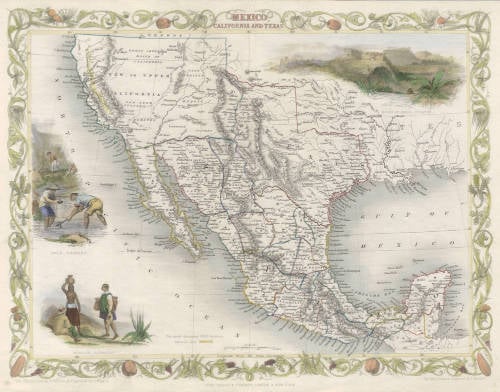Leen Helmink Antique Maps
Antique map of California & Texas by Tallis
The item below has been sold, but if you enter your email address we will notify you in case we have another example that is not yet listed or as soon as we receive another example.
Stock number: 18922
Zoom ImageCartographer(s)
Tallis
Title
Mexico, California and Texas
First Published
London/New York, 1851
This Edition
1851
Size
25 x 33 cms
Technique
Condition
mint
Price
This Item is Sold
Description
"Mexico, California and Texas", steel engraving by John Rapkin, published by John Tallis, London, 1851.
With decorative vignette views labeled
- Gold Washing (with index lower left The newly discovered GOLD districts Coloured thus []
- Ruins at Uxmal, Yucatan
- Mexican Peasantry
Seminal map showing California and the Goldrush, as well as Texas and Mexico. Original hand colour. Pristine collector's condition.
"John Tallis' Illustrated Atlas reflects a movement away from the sombre scientific style that so typified early nineteenth-century mapmaking. Published to commemorate the Great Exhibition of 1851, Tallis' beautiful maps, engraved on steel by John Rapkin, reflects the glories of Britain's world empire and provide a pastiche of images of far-flung corners of the world available for the first time to the Victorian armchair traveller."
(Barron).
"All the maps and plans have ornamental borders and most have vignette scenes; they are invariably described as 'the last decorative series of maps ...'. "
"Another series, which is especially popular for its decorative borders and vignette scenes, is that by John Tallis published in London and New York."
(Potter).
"Frequently referred to as 'the last decorative series of maps', these are attractively designed, informative pieces which combine the best elements of scientific cartography and decorative art as the great early mapmakers did. The decorative borders and attractive vignette scenes contrasted vividly with the austere approach of many other comparable atlas publishers of the time, whose use of decoration was negligible although the cartographic quality of their output was undoubted."
(Potter/Martin).
"... the last pictorial maps in the old tradition."
(Tooley & Bricker).
"The Illustrated Atlas presents a vivid and fascinating portrait of the nineteenth century world. Its main features were accurate, detailed and beautifully coloured maps; charming vignettes depicting cities, people and natural wonders of each country; informative passages by Montgomery Martin of facts and figures for every map compiled from the eye-witnessv accounts of explorers and a variety of authorative sources."
(Potter).
What follows is the original 1851 Montgomery Martin text that accompanies this map:
MEXICO, CALIFORNIA and TEXAS
The descriptions of Mexico, Texas and Yucatan must be reserved for other numbers of the Atlas. We shall here confine ourselves to Upper, or New California.
AREA AND PHYSICAL ASPECT
Upper or New California covers an area of about 350,000 square miles. Three mountain ranges, the Monterey Ridge, the Sierra Nevada range and the Wahsatch or Colorado Ridge divide the country into three districts. The largest of these, a table land some 4,000-5,000 feet above the sea, is a desert covered with the fragments of quartz and volcanic matter washed from the mountains. Indeed the character of the whole country is evidently volcanic. To the north there are many boiling springs of sulphur, salt, magnesia, and warm mud lakes. The mountain torrents carry down large quantities of granitic formations in which great mineral wealth will probably be discovered. Although New Helvetia and Francisco Plain have large and rich tracts for cultivation, the general aspect of the country is not so favourable for tillage: as for pasturage, which furnishes provender for herds of wild cattle, horses, deer and various animals. Three main rivers, the Colorado, the St Joachim and the Sacramento, are fed by numerous tributaries. The Sacramento is navigable for 50 miles for ships, and 150 for boats, and small steamers have now been sent there from the United States.
CLIMATE
Like other places on the west coast of America extreme temperatures prevail; there are blustering winds on the coast and intense heat in the interior, with sudden blasts of air from the snow-clad mountains, which bring on remittent fevers.
HISTORY
Discovered by a Spaniard in 1544, the country was later visited by Sir Francis Drake, to whom the Indians chiefs gave sovereignty for England. In 1822, when Mexico declared itself a republic, California was added to its territories, and after several revolutions and plots it was ceded to the United States in 1848.
CHIEF TOWNS
The capital, San Francisco, stands on one of the finest natural harbours in the world, which would hold all the shipping of England. In 1841 the town was almost in ruins, hut now its population numbers about 5,000, and if gold continues abundant it may hecome one of the most important cities on the Pacific coast. San Diego harbour also affords secure anchorage for merchant vessels and runs a considerabie distance inland.
POPULATION
The Indian inbabitants have been much diminished by small-pox and 'firewater'. In 1842 they were numbered at 14,500. It is probable that the number of whites is now 15,000. The Mormons have formed several stations and adventurers are flocking to California from all parts.
COMMERCE AND INDUSTRY
Although the auriferous appearance of the soil was first noted hy Drake in the sixteenth century, large-scale wet and dry digging for gold has only begun in the last few years. To what extent gold will continue to be found it is impossible to say; some ravines 100 yards long by 4 wide have yielded 17,000 dollars. Other metals also abound, induding cinnabar, copper, iron and silver.






